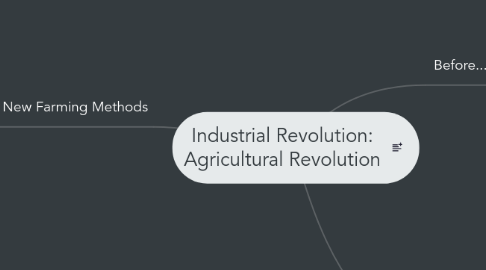
1. New Farming Methods
1.1. Four field system
1.1.1. Crop rotation
1.1.1.1. 1. Wheat
1.1.1.2. 2. Turnips
1.1.1.3. 3. Oats or barley
1.1.1.4. 4. Clover/grass
1.1.2. Advantages
1.1.2.1. Turnips and grass restored nutrients
1.1.2.2. Food supply increased, no fallowing
1.1.2.3. Cattle didn't have to be killed in winter
1.1.2.4. Fresh meat available all year
1.1.3. Charles Townshend
1.2. Enclosure
1.2.1. Advantages
1.2.1.1. Less weeds and disease
1.2.1.2. New farming methods
1.2.1.3. More food produced
1.2.1.4. Landlords could charge higher rents
1.2.2. Disadvantages
1.2.2.1. Small formers unable to meet costs of enclosure, had to go work in city
1.2.2.2. Labourers never owned land, lost grazing rights, went to work in city
1.3. Selective breeding
1.3.1. Robert Bakewell
1.3.2. Largest animals bred
1.3.3. Increased animal size
1.4. New agricultural machinery
1.4.1. Jethro Tull
1.4.1.1. Seed drill
1.4.1.2. Horse drawn hoe
1.4.2. Cyrus McCormick
1.4.2.1. Mechanical reaper
2. Before...
2.1. Open field system
2.2. Disadvantages of this
2.2.1. Field left to fallow
2.2.2. Time wasted travelling from field to field
2.2.3. Weeds could spread easily
2.2.4. Land unfenced, easily destroyed by animals
2.2.5. Animal diseases spread easily
2.2.6. Land wasted between strips
2.2.7. Land wasted where oxen turned
2.2.8. Farmers not free to try new ideas
